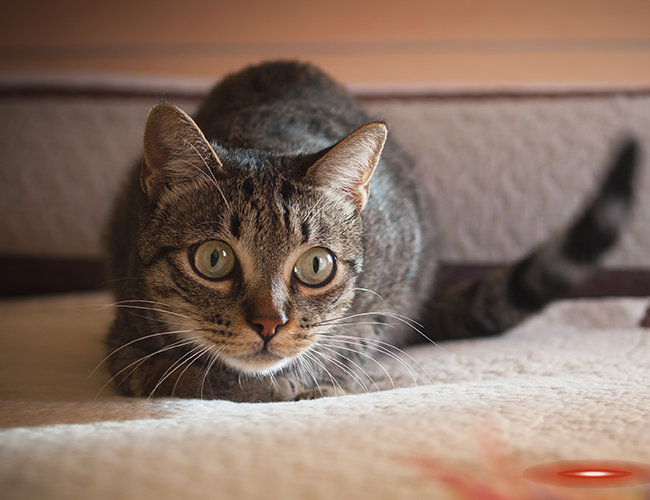
The game of cat and mouse has existed as long as felines have been prowling the planet. Chasing prey is second nature to a cat, so it is no surprise that many of the games we play at home with our domestic pets mimic the behaviors they would have in the wild. From feather-tipped fishing polls, to bouncy balls, yarn, string, and remote-control mice, there are an abundance of ways to help your cat practice his hunting and stalking techniques. Among these toys, the laser pointer has been a popular option for cat owners. People are easily amused by watching their kitty become mesmerized with the wiggly red or green dot that shows up on the wall. The constant moving and speedy flitting about will drive any cat wild, making the laser pointer a favorite tool to keep around. But is playing with a laser pointer actually a good thing for cats?
How does the toy benefit cats?
One important aspect of laser pointer play is that it instantly gets cats up and moving. Since felines have a tendency to snooze up to 18 hours a day, it can be tricky to encourage them to engage in an active way around the home. Laser pointer play is especially helpful for cat owners who live in cooler climates, and may not be able to take their pets outside that often. The intrigue this tool generates can encourage a lazy or unmotivated cat to get off his haunches and engage. Did we mention you are sure to get some giggles out of watching your kitty respond to the light? Laser pointers bring out an erratic and hilarious side of felines!
Since laser pointers are toys you can remotely control, you can easily manipulate it to get your cat’s attention (i.e. by shining the light on his paw, until he decides to chase the light around), or by keeping the dot just out of reach on the wall, so the cat will jump over and over again trying to get ahold of it. Laser pointers are unlike many other toys that will just lay limp when the cat stops batting them around. Because of the enticing light and constant motion, the cat will be more likely to get some great, long-lasting exercise out of his play time.
Dangers of Laser Pointers
While playing with laser pointers might be beneficial in some ways for cats, there are some obvious downsides that can also arise. For example, when a cat spends hours chasing and ever-moving light, without being able to successfully catch the prey, he may end up very frustrated. Being frustrated because the cat is never able to “win the game” by pouncing on tangible prey, might not only confuse the cat, but cause him to lash out in dangerous ways to himself or others.
Have you ever noticed when a cat watches free birds fly outside a window for a long time, without being at liberty to chase them, that the cat might immediately pounce on a nearby pillow, or try to scratch your pant leg to shreds? The same kind of pent-up anger can arise with cats who are ever tormented by that elusive light.
In some cases, pet parents have attributed their cat’s obsessive compulsive habits to being frustrated at play time. They might lick their coats or paws incessantly, or try to tear up any toy, sock, pillow or curtain corner they can.
Another concern that some pet parents have, is that the laser itself could be problematic if shone into the cat’s eye. However, the likelihood of this happening is very small, particularly if the cat owner is cautious not to get the beam too close to his feline’s furry face.
In summary, laser pointers are very useful tools that can be both entertaining for the human and physically beneficial for the cat. When used in balance and with other toys, the cat might avoid frustration or displaying negative behaviors, while having a great time working on his hunting and stalking skills.

